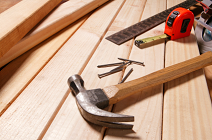
Clive Thompson in an article in Wired indicates hacking or DIYing might be good for American Innovation. We aren’t talking about illegal hacking, but hacking in terms of modifying personal gadgets and other possessions so they work better.
Thompson says that where companies are persuading consumers to buy, use and throw away, the legions of DIYers out there aren’t buying into it. In fact, they are using, reusing, rebuilding and modifying devices so they work more efficiently, have better features and last longer.
As an example, he points to people hacking their hybrid cars to get up to 100 Miles per gallon. He questions why Detroit hasn’t been able to do this and says “One reason might be that the engineers there spend all their time tinkering with CAD software,”
I’ve posted some of my own DIYs, here and on other sites so I certainly believe that hacking is good for you. But I didn’t do it for the higher good of improving American Innovation. I do it to save money and to improve my experience with my various gadgets. If I can hack my Pocket PC so it will connect through a Bluetooth tethered cell phone connection so I can check e-mail while riding down the highway at 65 Miles per hour, then I’ve both improved my experience AND saved money on cables and added service charges.
So if we agree that DIYing is a good idea, how do we get started? It’s simple. Continue reading 12 ways to become a master DIYer:
1. Don’t fear trying something new -
When you are new to modding, you might be afraid to use a soldering iron, you might be unsure of where to start at first. That’s ok, start with general areas instead. What interests you most? Do you like electronics, computers, woodworking or knitting? (yes there are mods for woodworking and knitting.) But start in your preferred general area and get to reading.
Start with Google and search for “yourinterest hacks”. You’ll be surprised at what you find and how motivated you’ll be to get started right away.
2. Start with something small -
Rome wasn’t hacked in a day. So if you are just starting out don’t start with a build your own personal helicopter project. Start with something manageable like one of the many LED projects you can find at Instructables or Make.Then as you learn, try more challenging projects.
2. Find the area you love -
Some people like LEDs, others like robots, I’m a connection guy myself. I like connecting different gadgets and making them work together. As you begin your quest as a master modder, then you’ll start to discover what focus you like best. Stick with that area so you can increase your odds of inventing something new.As a master DIYer, you’ll increase your odds of inventing the next big thing.
3. Build before you buy -
Isn’t it sad the day you pick up your iPod or remote control and suddenly it isn’t working? Not necessarily if you are a DIYer. Broken stuff presents a great opportunity to get under the hood and see if you can fix it.Once my son’s iPod wouldn’t start. I tried charging it, soft and hard resetting it. Still, all I saw was the sad mac face. ![]()
So I did some surfing and found a trick that just might work. I pulled out my Leatherman, opened up the iPod and placed a business card folded up underneath the hard drive. Low and behold, once I put it back together, the iPod booted and played music! In fact, I tried it again just this morning and it works fine.
4. Conserve your cash -
I think most passionate DIYers don’t like buying new stuff if there is a chance they can fix or make better what they already have. If you can just go out and buy a new Tivo any time you want it, there’s no real benefit to building your own PVR.The master at DIY knows electronics and gadgets decrease in value faster than a new car in a blasting zone. So if we can save money by repairing what’s broken, we have more money to spend on new gadgets and hacks.
5. Teach as you go -
One of the best ways to embed knowledge in your brain is to teach others. This enhances your creativity and once you’ve got others who know what you know, then there is great problem solving power in bouncing ideas off of each other.
6. Write procedures -
Unlike an elephant, humans can forget. You might remember a time when a great family recipe was lost because your aunt passed away or developed Alzheimer’s . I know there are countless great recipes lost forever due to the lack of a written recipe. My Grandmother’s gooseberry pie? Lost for eternity. My grandfather’s fried chicken? Nevermore…How better would it have been if they handed down written recipes. I could have archived it in a family recipe booklet for this and future generations.
When you create a new hack, be sure to write up procedures. Procedures let you go back in case you forget a resistor, measurement or solder joint. Plus, procedures are an easy way for you to teach others. You can even post your procedures to your blog to teach thousands of people your hack.
7. Take photos -
Photos of the steps in your procedures are perhaps the most powerful descriptors. You save time, by not having to write every last nuance of detail. Also, pictures cross all language barriers. You don’t have to know French to understand the Eiffel tower. The picture says it all.
Photos will allow you to also communicate your craft effectively with people from different countries and backgrounds. Additionally, there are a few of us who can’t read our own handwriting, a picture can rescue that DIY from being lost forever.
8. Study the Art of DIYing -
When you’ve found the area of hacking you love, study it. Collect books, articles and You Tubes of projects that interest you. You never know when you might have a rainy day and a box of LEDs just begging to be put together into a new Infrared headset.
9. Collect Parts -
Let’s face it, gadgets break. They age, and they become outdated. That doesn’t mean you have to throw it all away. An old (out of warranty) MP3 player is a good excuse to do some hacking. Take it apart and collect some of the more valuable parts inside. LEDs can be reused. USB ports can be reused. Some memory cards are good too. But don’t go too crazy with saving every last part and broken gadget.
A desk drawer full of spare parts is good – a shoe box full of parts is better. A garage cluttered with parts is a sign you don’t know how to separate the wheat from the chaff, so you are collecting everything. If that’s the case, it’s time to go back to studying.
Professionally, I’ve cleaned up server rooms where the admin(s) saved every last piece of broken equipment. Stuff piled 5 foot high where you couldn’t even walk. This is a sign that they don’t understand the equipment, what’s valuable and what’s not. When I get done, all that’s left is a filing cabinet of hot spare storage, Software licensing and a drawer full of emergency parts and cables. If an entire network DIY setup can consume just 1 filing cabinet, your home parts should fit into a desk drawer.
Note: Use caution when taking apart something that plugs into a wall – especially monitors. I don’t recommend taking apart old tube monitors because the tubes carry a charge and you can electrocute yourself. Just use common sense and read up before delving into an area you aren’t experienced.
11. Finish your projects -
Don’t be like the guy who has a car up on blocks in his front yard for 2 years. Finish your project or throw it out. Master DIYers always complete their experiments – even if they fail. If you fail, no biggie, throw it out and start something new. But what’s important is finishing. You can’t reach anuber -level of hacking expertise if you don’t finish your projects – plus, having a bunch of half finished projects lying around is an eyesore.
12. Have fun -
Most of all, this should be a fun adventure. It’s exciting to create something new and make it work. Once you learn a new mod, you’ve got a new McGiver- like skill you can whip out in a moments notice to fix a gadget, hack a buggy program so it works or create something you can sell at a profit. DIYing presents endless opportunities for fun and entertainment on those rainy days when you’re bored with nothing better to do.


{ 4 comments }
Doing something small is definitely the best way to start. For those of you who dare to try some fun little DIY projects around your house. Here are some Dangerously Fun little projects to try here, a great little DIY website I came across with great video instructions and most only take a few minutes to build and a few dollars of materials.
http://dangerouslyfun.com/
BTW: You may NOT want to try all these at home, however, they are FUN!
Mike, hehe… you’ll shoot your eye out!
I mainly became a DIYer because it was cheaper, but as I started making more money, I still do some. It pays to know how things work. Plus you learn a lot. And when you do it yourself, that’s the definition of custom. Let everyone else buy from Walmart.
Stephan Millers last blog post..Run Your Car on Water – A Clickbank Product Study
I believe people like to make something by themselves, it’s fulfilling. Especially when you are working for yourself either doing a makeover in your home or in your office. Some might say DIY is a trend, I believe it’s not as long as it’s profitable.
{ 3 trackbacks }